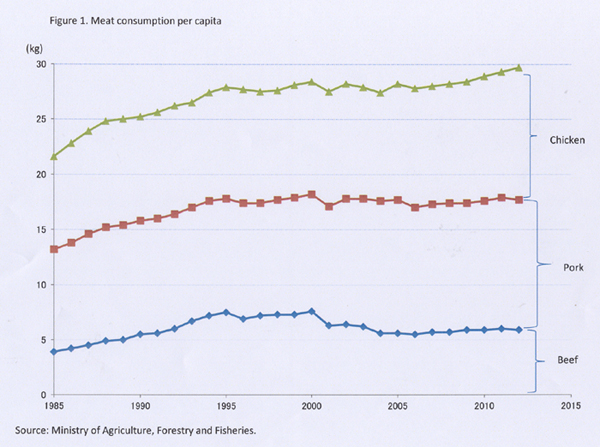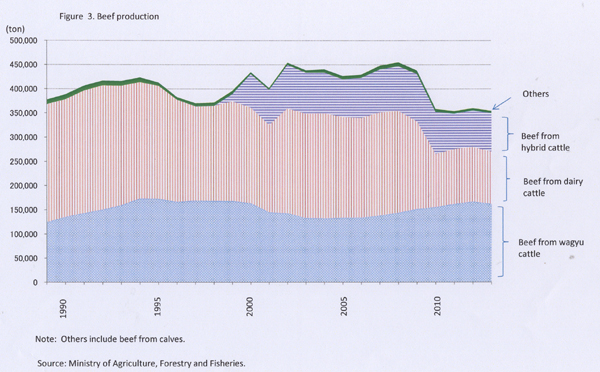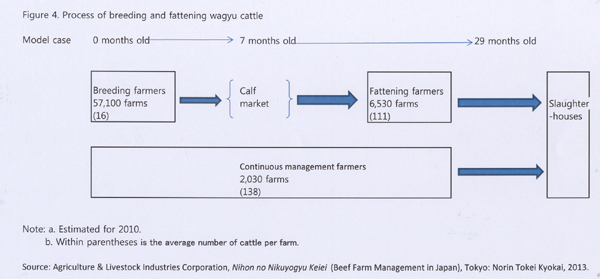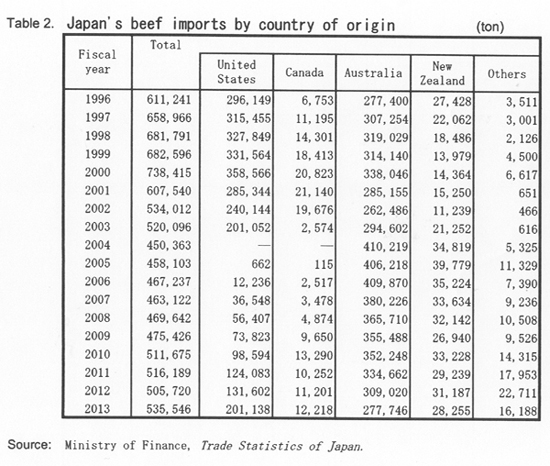What Are Farmers Facing With Selling Beef to Japananese Markets
Yoshihisa Godo
Professor, Meiji Gakuin University, Japan
INTRODUCTION
Although Japan is the third largest beef importing country in the world (US Department of Agriculture, Livestock and Poultry: World Markets and Traders), with imports accounting for nearly 60% of domestic beef consumption (Table 1), the trade barriers pertaining to Japan's beef market remain one of the key obstacles in international agricultural trade negotiations. For example, in the latest round of Trans-Pacific Strategic Economic Partnership Agreement negotiations, the US government urged Japan to remove all trade barriers for beef. In the same vein, in their Economic Partnership Agreement negotiations with Japan, the Australian and Mongolian governments also requested that it lower its tariff rate on beef imports. Against this background, the present paper provides basic information on the beef market and beef cattle farmers in Japan.
Beef imports in Japan
Until 1991, the Japanese government restricted beef imports by using an import quota. However, under pressure in international trade negotiations because such an import limitation violated GATT principles, which urge member countries to remove all non-tariff trade barriers, the Japanese government abolished its beef import quota and introduced a 70% tariff rate on beef imports. This rate was subsequently reduced to 60% in 1992 and was further reduced to 50% in 1993. Thereafter, according to the Marrakesh Agreement of 1994, the Japanese government reduced the beef tariff rate every year from 50% in 1994 to 37% in 2000, at which level it has remained since.
Table 1 shows that beef imports increased sharply until 2000. Before 2003, the United States and Australia were the major beef exporters to Japan, sharing nearly 80% of Japan's beef imports (Table 2). Immediately after the Bovine Spongiform Encephalopathy (BSE) outbreak was discovered in the United States in December 2003, however, the Japanese government prohibited US beef imports. In response, restaurants and supermarkets began to use more Australian beef. As a result, beef imports from Australia increased sharply from 2003 to 2005. After fierce discussions between the US and Japanese governments, Japan resumed beef imports from the United States under rigid conditions in December 2005. These conditions were gradually eased after 2005, and US beef imports have been increasing since. Nevertheless, today's total volume of beef imports from the United States still has not recovered to the pre-2003 level.
Beef consumption
Meat consumption increased significantly after the Pacific War. For example, beef consumption per capita is now nearly 6 kg per annum compared with 1.1 kg in 1960. However, as shown in Figure 1, beef consumption has not been on a continuous upward trajectory and has even declined several times in the past two decades. In 1996, reports of food poisoning because of E. coli O-157 reduced beef consumption by 10% compared with the previous year. For example, in July 1996, 7,996 persons in Sakai City were taken ill during a school lunch, one of the largest cases of mass food poisoning in the world. However, although infected beef was suspected as the source of the contamination, this was not proven officially. In 2001, the BSE infection was then found for the first time in Japan. As a result of rising customer anxiety about the safety of beef, consumption dropped again significantly. Similarly, the import ban on US beef in December 2003 caused a further reduction.
In 2011, more negative headlines about beef were reported by the Japanese mass media. In May 2011, 11 people who had eaten raw cow's liver in a popular franchise restaurant chain died. Three months later, high levels of radiation in beef were found because some farmers in the Tohoku Region had been feeding their cattle on rice straw that was highly contaminated with radiation following the accident at the Fukushima Nuclear Power Station. However, in contrast to the consumer reactions in 1996 and 2001, beef consumption did not decrease.
Meat consumption can be divided into three types: household consumption, processing (e.g., ham and sausages), and others (e.g., restaurants), as shown in Table 3. Since 1985, total beef consumption as a percentage of household consumption has decreased significantly in contrast to the trend for chicken and pork. This fact reflects that the removal of the beef import quota in 1991 followed by the subsequent reductions in the import tariff rate from 1992 to 2000 helped restaurants serve beef dishes (e.g., beef bowl) to consumers.
Types of beef cattle
Beef cattle in Japan can be categorized into three types: wagyu, hybrid (inseminating female dairy cattle with sperm from male wagyu cattle), and dairy. Figure 2 compares the price of Japanese and foreign beef. As shown in this figure, beef from dairy cattle, which competes fiercely with foreign beef, is the cheapest of these three types of Japanese beef, whereas beef from wagyu cattle is rich in marbling and demands the highest price. In order to avoid fierce competition with foreign beef, more and more dairy farmers prefer to inseminate mother cows with sperm from wagyu cattle. As a result, the production of hybrid beef has been increasing drastically (Figure 3).
Breeding and fattening cattle
Because the system for breeding and fattening wagyu cattle differs from that of the other two types, it is useful to describe the two systems separately. There are three types of wagyu cattle farmers, namely those involved in breeding, fattening, and continuous management. Figure 4 shows the process of raising wagyu cattle. As can be seen, breeding farmers impregnate cows and grow calves for nearly 9 months after their birth. Fattening farmers then purchase the calves and grow them until around 29 months old, at which point wagyu cattle are usually shipped to slaughterhouses. Those farmers that carry out both breeding and fattening are called continuous management farmers. Breeding farms are small in size and large in number, whereas fattening farms are larger in size and smaller in number. Continuous management of farmers are the smallest in number among the three types of breeding farms due to technical and financial reasons. First, different skills are needed for breeding and fattening. Second, including the pregnancy period, it takes nearly 48 months from the insemination of the mother cow to shipping an adult cow to a slaughterhouse. The financial risk of waiting for such a long period can be intolerable for small-sized farms.
Figure 5 shows the process of raising dairy and hybrid cattle. Dairy farmers keep mother cows to produce calves and milk but sell male dairy infant calves and hybrid infant calves to breeding and continuous management of farmers. Dairy farmers usually do not sell female dairy infant calves because they produce milk after they reach maturity. However, when dairy farmers are planning to reduce the production of milk, they may sell female dairy infant calves, too.
Breeding farmers raise infant calves until around 7 months old and sell them to fattening farmers. The fattening period for dairy cattle is two months shorter compared to that of hybrid cattle. As for wagyu farmers, those who carry out both breeding and fattening are also called continuous management farmers.
The average size of beef farms that manage dairy and hybrid cattle is much larger than that of wagyu farms, as shown in Figures 4 and 5. This distinction can be explained by the different management strategies needed to compete with foreign beef. Wagyu farmers try to overwhelm foreign beef by improving the quality of wagyu beef (by focusing on a limited number of cattle). By contrast, the major strategy of beef farmers for dairy and hybrid cattle is to reduce production costs by enlarging farm size.





.jpg)

(1).jpg)
Date submitted: July 29, 2014
Reviewed, edited and uploaded: July 30, 2014
rodriquezexpet1994.blogspot.com
Source: https://ap.fftc.org.tw/article/713
0 Response to "What Are Farmers Facing With Selling Beef to Japananese Markets"
Post a Comment